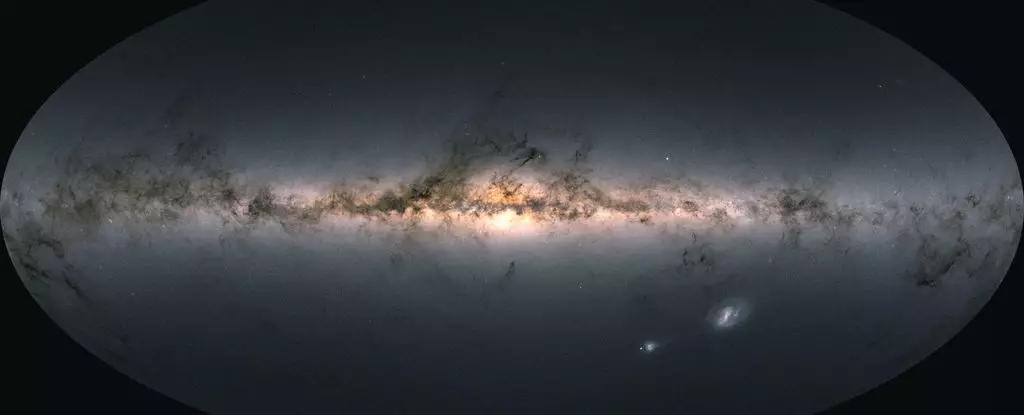Recent astronomical observations have pointed towards a remarkable finding: a supermassive black hole, shrouded in mystery, nestled within the Large Magellanic Cloud (LMC)—a dwarf galaxy that orbits our own Milky Way. This potential cosmic intruder is hypothesized to be around 600,000 times heavier than our Sun, igniting discussions among astrophysicists about its significance in the grand tapestry of black hole evolution. If confirmed, this discovery could redefine our understanding of the growth mechanisms of black holes, particularly those that transition from relatively small masses to titanic cosmic behemoths that dwarf even the largest stars.
The LMC, known for its picturesque beauty as an apparent collection of bright points in the southern hemisphere’s night sky, is not merely a static backdrop. Instead, it is engaged in a slow gravitational ballet with the Milky Way, inching closer over cosmic timescales. With an estimated collision predicted to occur in roughly 2 billion years, the implications of a hidden supermassive black hole within this galaxy could extend far beyond mere curiosity. As it draws nearer, this black hole may be propelled into a collision course with our own galaxy’s central supermassive black hole, Sagittarius A* (Sgr A*), measured to be about 4.3 million solar masses.
Detecting a black hole isn’t as straightforward as one might think. Unlike stars, which shine brightly due to nuclear fusion, black holes are notorious for being elusive. They do not emit detectable radiation unless they engage in a cosmic feeding frenzy, where matter is drawn in, heating up and radiating energy in the process. Instead, astronomers must rely on ingenious methods to infer their presence, often observing the orbits and motions of nearby stars to unveil the gravitational influence of the unseen massive object.
In this case, the team led by astrophysicist Jiwon Jesse Han at the Harvard & Smithsonian Center for Astrophysics approached the problem from a novel angle. Instead of focusing on the subtle movements of stars in orbit, they concentrated on hypervelocity stars—celestial objects that zip through space at speeds that far exceed the typical velocities of stars within a galaxy. By analyzing the behaviors of these outliers, Han and his colleagues sought the clues that could reveal the existence of a lurking black hole in the LMC.
Hypervelocity stars are a fascinating class of celestial bodies that move at astonishing speeds, capable of escaping the gravitational grip of their home galaxy. The researchers employed Gaia data, a treasure trove of information collected over several years by the recently retired space observatory, which meticulously mapped the positions and velocities of a multitude of galactic objects in three-dimensional space. The analysis of 21 hypervelocity stars showed patterns consistent with the Hills mechanism, which is a three-body interaction scenario involving a black hole and two stars.
This mechanism posits that a black hole can accelerate stars through gravitational interactions, propelling them into the galaxy at incredible velocities. The study revealed that 16 stars studied could be traced back to their origin, with seven of them linked to Sgr A* and the remaining nine tracing their roots to the Large Magellanic Cloud. The implications were startling. They indicated a mass concentration of around 600,000 solar masses within the LMC, a compelling hint at a hidden black hole waiting to be confirmed.
The prospect of this potential black hole merging with Sgr A* in the far future presents a fascinating scenario for astrophysics enthusiasts. Such cosmic interactions are not uncommon but are pivotal in contributing to the growth of supermassive black holes. As galaxies collide and merge, the gravitational interactions can result in the amalgamation of their central black holes, leading to the creation of even larger entities. This cycle of cosmic evolution is a central theme in the study of black holes and their role in shaping the universe.
Although we may never witness this celestial spectacle in real time, the study of such phenomena offers invaluable insights into our universe’s history and future. Future research is paramount in confirming the existence of this intriguing black hole and understanding its properties, shedding light on the early stages of black hole formation and growth. As we advance in our exploration of the cosmos, every discovery adds yet another piece to the puzzle of our universe, propelling us toward a more comprehensive understanding of its mysteries.

